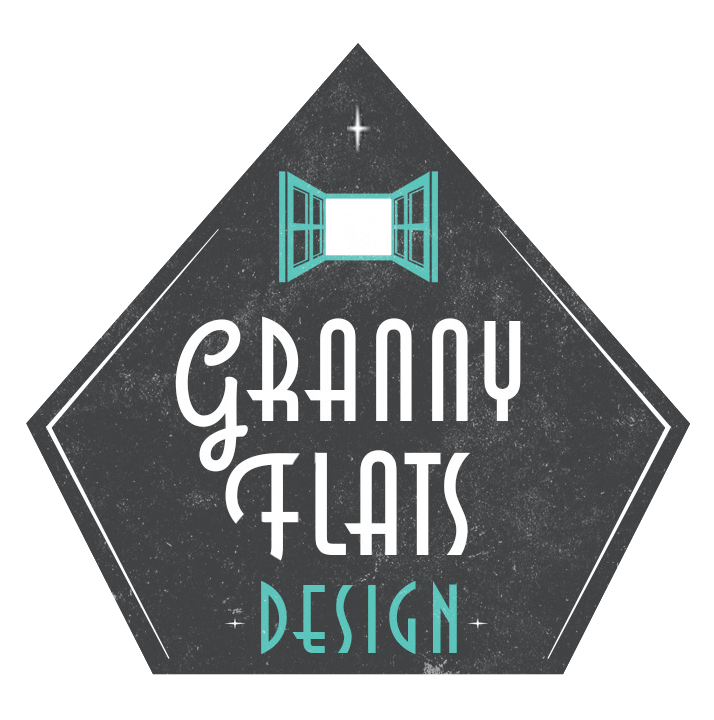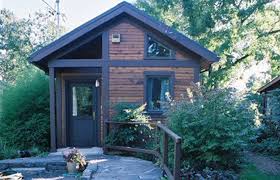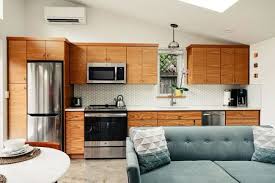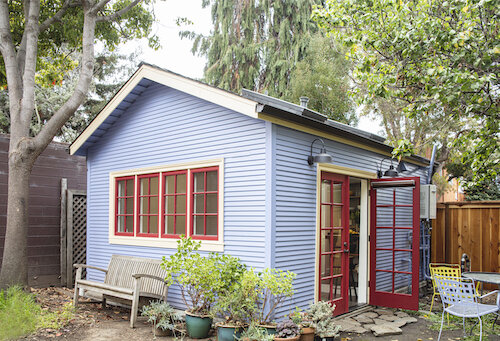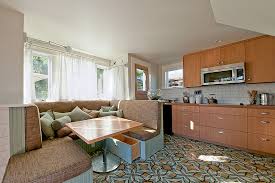Granny Flats in Los Angeles

Published By Brittnay Sharer
Date: 01/10/2021
ADUs, granny flats, tiny houses, garage conversions. These are all the hot new buzzwords in home improvement projects in Los Angeles. But whether you call it an ADU, a granny flat, a tiny house, or a garage conversion, what are these structures that are popping up all over LA?
What is a granny flat in Los Angeles?
Think of a granny flat as an apartment. Granny flats are usually constructed by converting an attached or detached garage, a large shed, basement or attic into a stand alone apartment, complete with a bathroom and kitchen. Also known as accessory dwelling units (hence, ADU), these structures are usually about 250 to 1200 square feet. Whether attached or detached, these granny flats must exist on single family homes, and have their own entrance, kitchen, bathroom and living space.
For years, homeowners have been converting under utilized space in their homes and property into these granny flats. Unfortunately, most of that work was done with permits, because properties had to be zoned for multiple housing units. However, all that has changed in recent years. The state of California -- in an effort to ease the historic housing crunch -- now allows, and even encourages, the construction of ADUs or granny flats on single family properties. In fact, it is illegal for local jurisdictions to deny a home owner’s request to build an ADU on his or her property.
Most homeowners tend to convert garages -- either attached or detached -- into granny flats. Most of the time, a contractor can easily use the existing structure to create a one-bedroom or studio apartment. However, in some cases you may have to tear down your existing structure and rebuild your granny flat. This usually happens if there are structural problems with the existing garage that cannot be easily repaired or repaired in a cost-effective manner.
Why might you want to convert your garage into a granny flat in Los Angeles?
There are so many reasons why homeowners construct a granny flat on their property. The main reason? It’s probably economics. Your home will increase in value when you add an ADU to your property. In addition, if you decide to rent out your granny flat, you will be making extra income in the form of rent.
How you choose to rent out your granny flat will depend on what you are looking for in your own living situation. Younger families may appreciate the extra income they receive by renting out a granny flat. In that case, the family may choose to live in the main house and rent out the ADU. However, empty-nesters or those who don’t need as much space may decide to live in the ADU and rent out their main house. Either way, you, the homeowner, are going to make money on the flat.
When you rent out your ADU/garage conversion/granny flat, there are some things to consider. First of all, consider all the factors of renting into account. This includes screening tenants, placing ads and deciding how to cost-share utilities.
The average rent for an ADU is $1700 a month in Los Angeles . After monthly expenses including utility fees and upkeep costs, you can expect to make about $860 of income per month from your ADU!
I’ve heard about rent control. What’s the deal with rent control and granny flats in Los Angeles?
Any rental that is 15 years old is under rent control. The new state rent control law exempts buildings constructed in the last 15 years. That means, if you build your granny flat this year, it won’t be eligible for rent control for 15 years.
However, your property could come under rent control restrictions in certain circumstances. Say you decide to move into your new ADU and rent out your main residence. Your property no longer is a single-family home. And if your main residence was built before 1978, it qualifies for rent control.
How do I finance my granny flat in Los Angeles?
Building a granny flat costs between $80,000 to $120,000 depending on the amount of construction involved. While this price tag may take your breath away, just remember that most homeowners are able recoup the cost of construction with the extra income they will collect in rent. Also, there are ways to pay for your new ADU without breaking the bank.
Home Equity Line of Credit
As a homeowner, you are probably already paying off your mortgage or you own your property. Either way, you can borrow against the value of your home.
One of the most common ways to borrow against the value of your home is through a home equity line of credit, also known as a HELOC. This is a line of credit secured by your home that gives you a revolving credit line to pay for large expenses.
To qualify for an HELOC, you need to have equity in your home. That means, the amount you owe on your home must be less than the amount your home is worth. You can usually borrow up to 85% of the value of your home, minus the amount that you owe.
Cash-Out Refinancing
Another way to pay for your ADU is through what’s called a cash-out refinancing of your mortgage. With a cash-out refinancing of your mortgage, you will get a lump sum payment. How?
Basically, you replace your current home mortgage with a new one. This new home mortgage would be higher than your current home mortgage. Then, you can take out the extra money and use it towards your ADU.
With interest rates at historic lows, this would be a great option. In addition, the money you collect from a cash-out refinance isn’t considered income, so you don’t have to pay taxes on it. Instead of being considered income, the cash out is considered to be a loan.
Construction Loan
Yet another option is a construction loan. One of the many benefits of building an ADU is that it increases the value of your property. That makes it appealing to banks, who may give you a construction loan. With a construction loan, you would refinance with a mortgage that reflects the house's estimated value after you construct your ADU. Many lenders provide mortgages that cover up to 80% or 85% of the remodeled home's value.
With a construction loan, your bank will first assess the value of your property. Then, an appraiser will calculate how much they believe your home will be worth after an ADU is built. The bank will also take into consideration how much it will cost to convert your garage. Once all those factors are determined, the bank will provide a certain percentage of that difference for you to finance the cost of construction.
With a construction loan, the bank plays a larger role. The bank approves the general contractor selected by the homeowner. Then, the bank releases money at various stages in the construction process, which may involve an inspector verifying the progress. While these inspections may involve fees, this approach protects both the bank and the homeowner, who may not be familiar with how to oversee a major home construction project.
If you want to convert your garage and need help funding your project, give us a call. Our lending professionals have the experience and know-how to get you into an ADU/garage conversion today! Call Granny Flats Design at 818-532-0482.
